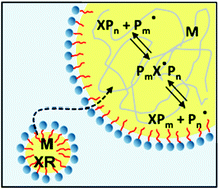Reversible addition-fragmentation chain transfer polymerization in microemulsion
Abstract
This tutorial review first details the uncontrolled microemulsion polymerization mechanism, and the RAFT polymerization mechanism to provide the necessary background for examining the RAFT microemulsion polymerization mechanism. The effect of the chain transfer agent per micelle ratio and the chain transfer agent aqueous solubility on the RAFT microemulsion polymerization kinetics,


 Please wait while we load your content...
Please wait while we load your content...